The Sawmill
In 1901, Ed
Hawn was looking for a new location for the sawmill he owned and
operated in Olivet, in Pierce County. When he reached a point seventeen
miles north of Boyd, he found a large area of plentiful hardwood and
hemlock. This area, as most of the others in Wisconsin, already had lost
its pine before the beginning of the new century. Many of the large pine
logs had been left on the ground partly because there had been too
little snow and water to get them out when the pine was logged, and
partly because the contract stated "all tops down" by a
certain date.
Ed Hawn liked the timber outlook and negotiated for the purchase of the
land. He bought several sections of land outright and only the stumpage
on other sections. He brought the sawmill, planing mill, lath mill, and
shingle mill to the new location in the fall and winter of 1901. Part of
it was shipped by rail to Boyd and from there it had to be hauled by
wagon and sleighs for seventeen miles. There was only a trail through
the woods for the last two miles. Approximately two hundred loads were
required to transport these materials which included not only the
machinery, but the timber and lumber needed to build the mill. The
heavier parts of the mill, such as the boilers, the engines and the big
fly wheels were shipped to Arnold, which was a point seven miles north
of
what is now called Ruby. These were hauled the rest of the way on the
extra-wide logging sleighs over a widened trail through the woods.
When Mrs. Hawn and daughter, Ruby, came to join Ed Hawn, they traveled
by train to Chippewa Falls expecting to continue by rail to Arnold, but
they learned that the train went only every second day; so they were
invited to spend the extra time with the conductor and his family in
Chippewa. On the following day they again started on their journey
discovering that the train went only as far as Holcombe, but that the
engine could go on to Arnold. They rode in the cab of the engine over
rails that were yet without ballast. Mr. Hawn met them at Arnold with
horses and sleigh to complete the trip to their new home.
By Mrs. Minda Leonhard July 16, 1956
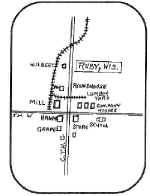 The first
building that was erected after the mill began sawing lumber was a
rectangular two-story structure with a lean to on each side. The Hawn's
occupied one lean-to while the other was used for storing the necessary
equipment needed for maintaining a mill. The central part was for the
"wanigan" which meant the large supply of workmen's clothing
from which each man could select his needs and charge the cost against
his wages. A little later this part of the building was used for the
general store and Post Office.
The first
building that was erected after the mill began sawing lumber was a
rectangular two-story structure with a lean to on each side. The Hawn's
occupied one lean-to while the other was used for storing the necessary
equipment needed for maintaining a mill. The central part was for the
"wanigan" which meant the large supply of workmen's clothing
from which each man could select his needs and charge the cost against
his wages. A little later this part of the building was used for the
general store and Post Office.
|
The above pictures are of the Ruby Lumber Company built by E.L. Haun founder of the firm of Sill & Haun. Mr. Haun came to this area in 1902 and named the town Ruby after his only daughter. |
The second building from the new lumber was the big company barn. It was
big in those days, but now would be an average size, for it was
approximately thirty feet wide and eighty feet long. There was a
lean-room for storing logging equipment. Mr. Hawn had several teams of
horses and oxen of his own and he hired more teams from some of the
neighboring settlers.
One or two years after the building of the road, or turnpike, work was
commenced on a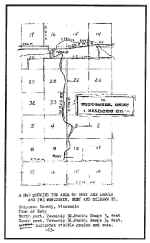 railroad between Ruby and Arnold to aid in the hauling of
lumber and logs. Due to the swampy conditions of much of the land where
the road had to be built and because of too much rain at the time, as
well as to the lack of adequate machinery, this proved to be a very
large task. In spite of adversity, the railroad was completed and served
its purpose for many years. Then Henry Grape took the job of guiding the
"Stump Dodger" over the crooked railroad to Arnold. Many
million feet of lumber were shipped over that railroad from the Ruby
Lumber Company which was composed of Messrs. Hawn, Sill, and Hamilton.
The latter two were from the Minneapolis Lumber Company of which the
Ruby Company was a branch.
railroad between Ruby and Arnold to aid in the hauling of
lumber and logs. Due to the swampy conditions of much of the land where
the road had to be built and because of too much rain at the time, as
well as to the lack of adequate machinery, this proved to be a very
large task. In spite of adversity, the railroad was completed and served
its purpose for many years. Then Henry Grape took the job of guiding the
"Stump Dodger" over the crooked railroad to Arnold. Many
million feet of lumber were shipped over that railroad from the Ruby
Lumber Company which was composed of Messrs. Hawn, Sill, and Hamilton.
The latter two were from the Minneapolis Lumber Company of which the
Ruby Company was a branch.
(Maps shown above are courtesy of Craig Sinclair from the book Ruby Township Centennial 1906-2006)
Among those
who helped color the life in the community was A.D. Shattuck, a salesman
for the Chippewa Valley Mercantile Co. The greater part of the business
of the general store, except for hardware, was supplied by that company.
Mr. Shattuck was a regular caller for over thirty years, and his
automobile was the first that was seen in the Ruby Community.
Another familiar figure was a Mr. Hanson who was a jeweler. He made
visits to the logging camps and sawmill town selling and repairing
watches.
Town meetings were held over the Ruby Store until 1910 when the Town
Meeting were held in Arnold, thereafter
Fire spelled disaster three times for the Ruby Lumber Co... In 1907, or
near there, the lumber yard burned causing a complete loss of four
million feet of lumber. No insurance was carried because of the high
premium due to the prevalent fire hazards. The planing mill burned
several years later, and in 1915 the big sawmill burned. It was rebuilt
but not as large as before the fire. The threat of forest fire was
always imminent in dry weather. People filled trunks with food and
clothing and buried them in their yards in the event that their houses
would born.
Tragedy as well as success visited this little community. As early as
1904 a logging accident took the life of a young man named Ben Smith who
lived about two miles from the mill. While he was loading logs, one of
them broke loose, rolled over him, and caused a sharp stick to puncture
his temple. Some years later, a little boy, Danny York, drowned in the
hot pond.
Another near tragedy took place when Mr. Hawn narrowly escaped death
when his head was crushed between two logs that were being decked . He
was taken to the nearest hospital, which was in Chippewa Falls,
thirty-five miles away. Here a silver plate was inserted to replace the
crushed bones. After recovering he came home and was quite active for
fourteen years. With his passing in 1924, came the end of the saw-mill
era for the hamlet he had built.
Mrs. Ed. Hawn survived her husband by thirty years. Since her bleak
journey to Arnold in the cab of the train engine in 1901, she lived to
see the advent of the automobile, radio, and television. Before her
death, she visited California several times, going and retuning on
commercial airliners.
Information from Arthur Baker, Arne Bjerke, Elmer Bjerke, Eugene Filteau,
Nat Hurlburt
Walter Leonhaed and Fred Olmstead. Photographs Mrs. Daniel Anderson
(Ruby
Hawn) Mr. and Mrs. Henry Grape.
After the railroad was completed between Ruby and Arnold, the mail was
brought up on the train by the crew. This train was affectionately known
by some as the "W.R.&S." (We Run Slow) as it dodged the
stumps. Art Burlingame helped dynamite the road bed for the railroad.
Fred
Olmstead was hired by the Minneapolis Lumber Company to come to Ruby as
a foreman for the mill operated by Mr. Ed. Hawn. Mr. Hawn was one of the
partners in the Minneapolis Lumber Company and was called the ground-man
or "on the job." Soon Mr. Hawn severed this partnership and
the company became known as the "Ruby Lumber Company"
Mr. Hawn had bought the Polley homestead from William Polley and used
one of the two log buildings for a cook shanty. Mr. Polley's son
Charlie, had been running the crew up until now. Mr. Olmstead's early
experience of working men was to get as much out for his company as possible. Each dollar was counted against the number of logs.
Subsequently, the next morning he discovered at daylight, the men were
still at breakfast and had yet to water their horses, grind their axes
and prepare for the days work. He announced that from now on this was
all to be finished before daybreak so the men would be ready for the
woods at that time. He also canceled the men's frequent days of deer
hunting without loss of pay. Mr. Hawn backed him up 100 percent with all his changes and
the men had no choice but to fall-in-line.
Pete and Otis Hanson were carpenters and built the Ruby Store, school
house and homes for the settlers.
Every village in those days depended on the Village Blacksmith, William
Crawford, who had moved from Boyd, was the village Blacksmith in Ruby.
He shod the horses, welded and repaired the wagons. His blazing forge
and anvil kept the equipment at the sawmill in operation. He also had
the position of mail-carrier on Star Route between Arnold and Ruby. He
ran a "Pony Express" until the railroad was established
between these points.
Mr. Olmstead was foreman of the Ruby Lumber Company. The logs were
brought in from the nearby timber and dumped int the "hot
pond" which helped remove the bark more easily. It was sawed into
lumber which was sent by horses to Arnold to go by train to Holcombe and
the Minneapolis Lumber Company.
Mr. Olmstead cut the railway for the tracks to be laid for a train known
as the "Stump Dodger". It ran from Arnold to Ruby every other day and
hauled the lumber, mail and food supplies for the people. Jack Carlin
was the first engineer and served for many years.
|
Motive Power on this little line was an 0-4-4 made by Forney. Forney engines had 4 drive wheels under the tank and boiler to support the water weight, and 4 wheels under the cab to support the fuel. The WR&S engine nick named the "Stump Dodger" came from the Chicago Elevated System when they converted from early steam to electric. |
A regular man would come to the camp about once a month and sell tickets
to the Chippewa Hospital. Every time he sold some, Mr. Olmstead, the
foreman, would get tickets for a free physical check-up.
Before 1923 (exact year not remembered) the farmers were producing
enough milk so they built a cheese factory near the Ruby corner which
was managed by George Haum.
The saw mill had a day crew and a night crew after they got their
lighting system. Hand Grape was day engineer at the sawmill and Joe
Betterly was night engineer. Fred Britten was first head sawer, 2nd John
Holden, 3rd Ferd McCain, and 4th Con Hessler.
Over the Ruby Store was the old Town Hall where they had dances basket
and pie socials and "get togethers".
The Community History
Mr. and Mrs. Henry Grape had an orchestra and played for many social activities.
Maple Syrup Industry: Two sugar bushes produce many gallons of maple syrup annually. They are owned and operated by Dan Anderson and the Grape family respectively.
Leonhard"s
Store, located at the Junction of County Trunk G and State Highway 64,
serves
the community, today, as it has for the past thirty years. It is one of
the landmarks of our day. (1958)
This store was built by William H. Crawford in the fall of 1928. It was
purchased by the
Leonhards (Walt and Minda) the following year. There was no clearing, no
well, no electricity, and very little driveway. We moved our last load
of furniture in June and got stuck on State Highway 64.
Gas was used for lights until about 1936 when a used Delco Lighting
Plant was purchased for 20.oo. Old car batteries were used until better
ones could be obtained.
Farm wives brought in homemade butter to exchange for groceries.
Mr. and Mrs. Lee started selling minnows in July of 1951.
The three leading crops are hay, oats, and corn. Most of the corn is
used for silage.
1958 The town of Ruby is serviced by four stores: The Ruby Store, owned
and operated by Stanley Rejzer; Leonhard Store owned and operated by
Walter Leonhard and the Arnold Stores, owned and operated by Bolts and
Lompa.
Most of the standing timber in Ruby, today, is cut and sold for railroad
ties, lumber, or pulp.
Ruby Store "The Friendly Working Man's Store Saves You More"
One mile north of Hwy. 64 on G. Holcombe, Wisconsin. Ruby Surplus
Outlet, Groceries, and gas.
Leonhard's Store The handy stopping point directly on your route.
Junction Hwy. 64-Co. T. G. Groceries and Gas.
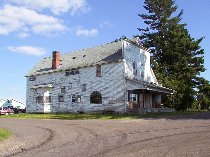
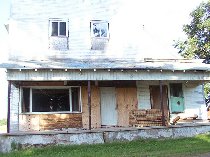 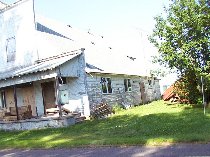 |
| The Ruby Store as seen today. It appears to be going through some major modifications to bring it back to life quite possibly as a residence. Ruby now holds a couple of newer houses to replace the older ones now gone. About the only thing remaining from the era modeled is the Ruby Store. My sisters and I used to pick cucumbers when we were younger, and the store used to buy them. Not sure what they did with the bushels that we brought, but it was good money for movies and things. |
If you have any new information, stories, corrections, or pictures regarding this or any of the other towns along the Hannibal branch line, Please let me know, < E-mail > along with your permission to publish your personal memories in an attempt to keep the history available for future generations. Non-digital pictures and information will be returned upon request.
Thanks for looking,
Doug Stoll